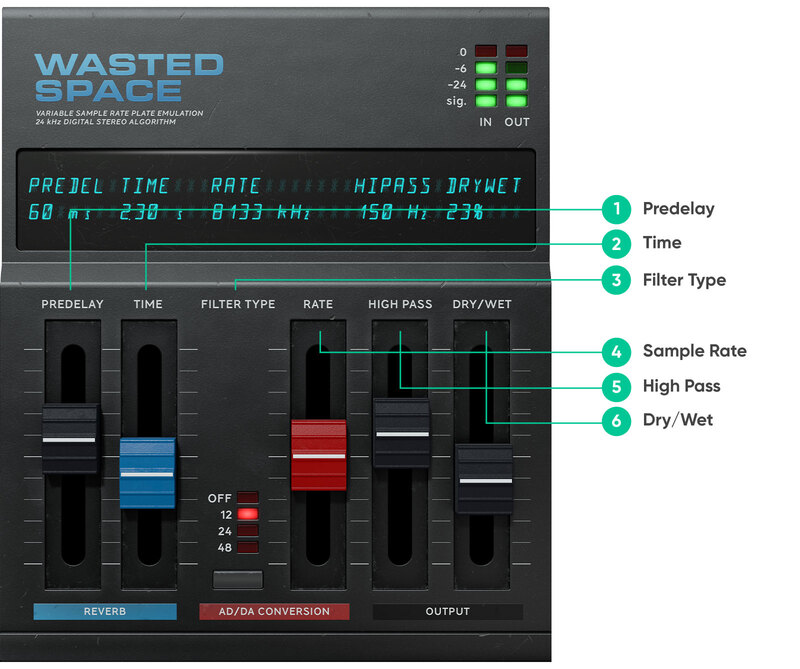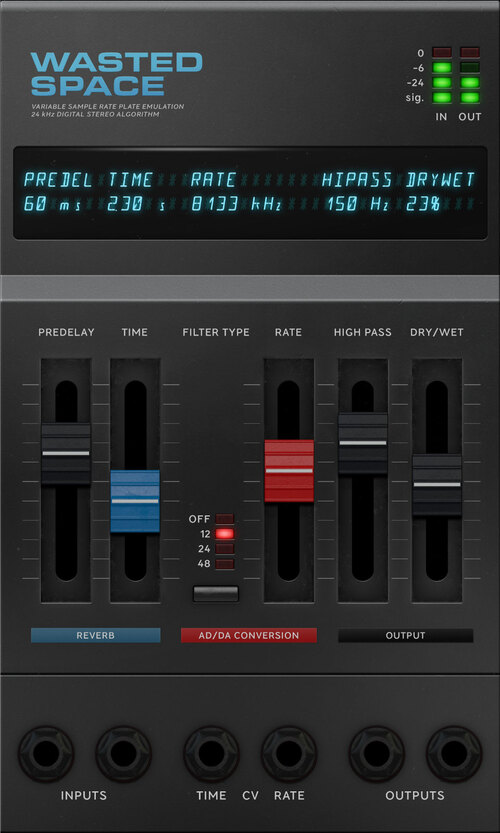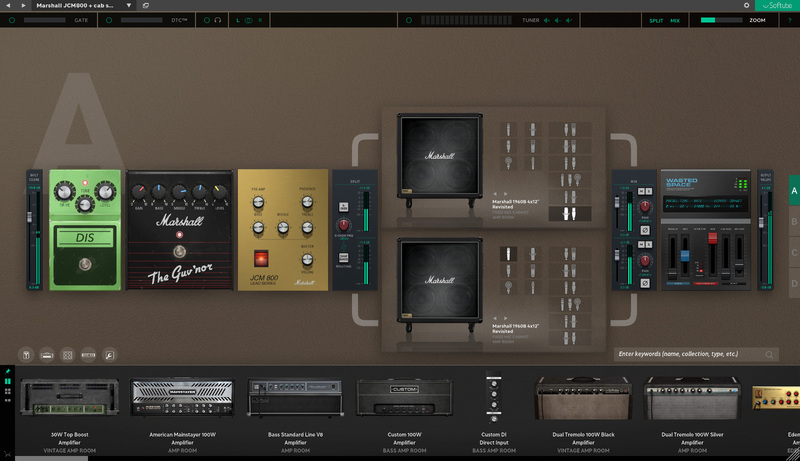User Manual
Wasted Space
Intro
User Interface
Presets
Extended Features
Wasted Space module in Modular
Wasted Space in Amp Room
Credits
For a long time, we had a dream about creating an imperfect reverb. This is it: Wasted Space. Sometimes, bad things happen to good reverbs. But sometimes, bad sounds good!
Wasted Space mimics an early digital-era plate reverb with all the quirks and digital artifacts turned up to 11. It is designed to be easy to dial in, with only a few parameters that all alter the sound drastically. Wasted Space excels at adding an otherworldly, ghostly sheen to your tracks. A vast expanse of ethereal digital noise is now available at your fingertips!

Click here to view the full-sized image in a new tab
1. Predelay
2. Time
3. Filter Type
4. Sample Rate
5. High Pass
6. Dry/Wet
Reverb Parameters:
Predelay
The Predelay sets the time between the dry signal and the reverb tail. It is often used to achieve the impression of a large room, by making the reverb tail arrive later.
Time
Sets the decay time of the reverb tail. This is the time it takes for the volume of the reverb tail to drop 60 dB. The decay time is adjustable between 0 and 4.5 seconds.
AD/DA Conversion Parameters:
Filter Type
Your choice of 12, 24, or 48 dB/octave aliasing filters, or turn them off completely. While none of these filters are "perfect", the 48 dB/octave filter will give you the least amount of artifacts, for when you just want a nice vocal plate. When set to OFF or 12 dB, the aliasing will introduce atonal high-frequency content for frequencies above half the sample rate, which can thicken the sound, put a sheen on it, or just make it sound weirdly robotic.
Sample Rate
Introduce aliasing artifacts by varying the sample rate between 2400 and 24000 Hz. How Lo-Fi can you go? The original algorithm ran at 24000 Hz, which means that no frequencies above 12000 Hz “exist”. Since no frequencies above half the sample rate exist, everything above that frequency will either be atonal aliasing artifacts (with Filter Type = OFF) or filtered out. You can therefore use Sample Rate as a low pass filter for your reverb (with Filter Type = 48 dB/octave).
Output Parameters:
High Pass
The High Pass filter cuts low frequencies up to 2000 Hz and can be de-activated by turning the parameter to the “OFF” position.
Dry/Wet
Sets the mix between the direct signal and the reverb signal
Caution: The AD/DA converter in this virtual plate is seriously flawed on purpose. Here be artifacts!
Tip #1: A cool way to get a darker reverb is to play with the Rate and Filter parameters.
Tip #2: Set Predelay and Time to 0, wet to 100%, and then play around with the Filter Type, Rate, and High Pass parameters. Instant fun!
The included presets are all made to show off Wasted Space as an insert effect.
If you want to use presets while using Wasted Space as a send effect, make sure to drag the Dry/Wet slider to 100% wet.
A whole range of added control can be accessed with Extended Features. Please see the separate "Extended Features" manual for more information.
Wasted Space module in Modular

Wasted Space can also be used as a separate module in Softube Modular. This is a brief description of the added functionality in Modular:
Parameters
Time: Sets the decay time of the reverb tail
Predelay: Sets the time between the dry signal and the reverb tail
Filter Type: 12, 24, or 48 dB/octave aliasing filters
Rate: The sample rate is variable between 2400 and 24000 Hz
High Pass: Cuts low frequencies up to 2000 Hz
Dry/Wet: Sets the mix between the direct signal and the reverb signal
Inputs
Left input
Right input
Time CV input: External CV control of the Time parameter
Rate CV input: External CV control of the Rate parameter
Outputs
Left output
Right output

When purchasing this product, you automatically gain access to running the plugin as a module inside the Amp Room platform. The module can be matched and arranged together with any other native Amp Room module or other Amp Room-ready modules that you might own.
Niklas Odelholm – Concept, modeling, product management, sound design, graphic design, UI
Maxus Widarsson – Product management, presets, manual
Mattias Flygare - DSP and UI programming
Pelle Serander - UI programming
Ulf Ekelöf – 3D rendering
Patrik Holmström - Framework and UI programming
Johan Bremin - Quality Assurance, presets
Kristofer Ulfves - Presets